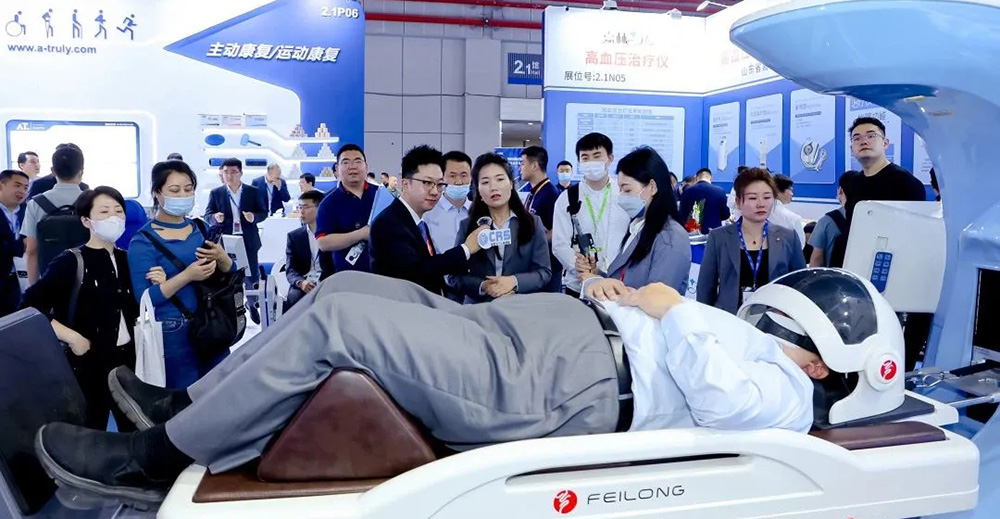Olex Nykytyuk, our Shanghai-based medtech specialist, has just been to CMEF – China’s largest medical device event. He reports on what he saw, with more analysis of the opportunities for western firms in China’s medtech sector to follow soon …
Stepping into the bustling halls of CMEF 2023, I found myself immersed last week in a vibrant showcase of innovation, industry collaboration and cutting-edge technologies.
As I navigated the crowd, the sheer scale of the exhibition made a deep impression on me. With 5,000 exhibitors, including more than 200 international companies, and a staggering 200,000 visitors, the atmosphere was truly buzzing.
And the absence of masks underlined the emergence of the Chinese medical device industry from a semi-dormant state induced by the COVID pandemic.
What was new?
2023 has, so far, been the year of artificial intelligence, with the medical device industry no exception.
At CMEF, I saw a wave of AI-powered advancements across various verticals of the medical device industry. Shanghai United Imaging, for example, showcased the uMR Jupiter 5.0T – the world's first whole-body, ultra-high field 5.0T MRI. It integrates AI capabilities to accelerate magnetic resonance imaging.
InferVision attracted attention with its AI-augmented 3D preoperative planning platform. This looks set to revolutionize surgical planning through the visual reconstruction of bodily organs.
And companies including BOE Technology Group and Mindray demonstrated ultrasound imaging equipment with AI detection modules, boasting detection accuracy above 90%.
Another prominent trend at this year’s CMEF was the drive towards digital transformation.
Ping An Good Doctor was among the standout companies demonstrating their telemedicine systems. Ping An’s platform enables patients to consult doctors remotely via video calls, providing convenient access to healthcare services anytime, anywhere.
The growing competition in telemedicine is indicative of the increasing number of companies offering digital solutions for healthcare management, and this fusion of technology and healthcare is poised to revolutionize patient care.

Hot verticals
Within the broad realm of medical devices, certain verticals stood out at the show, attracting significant attention from visitors.
Precision medicine and genomics garnered immense interest, with companies showing their latest genomic sequencing platforms, molecular diagnostics and genetic testing solutions. Capitalizing on expertise accumulated during the COVID years, molecular diagnostic companies are making strides in overcoming the technological bottlenecks that previously hindered the industry.
The market is witnessing the introduction of fast (sub-30 minute), all-in-one diagnostic instruments that operate in standard laboratory environments without the risk of contamination.
China's widespread implementation of 5G broadband internet has also facilitated notable developments in the surgical robotics space.
Shanghai Medbot – featuring laparoscopic, orthopaedic and vascular intervention surgery robots – provided fascinating data based on more than 800 successful operations, some undertaken on patients who were thousands of kilometers away from their surgeons.
Beijing Wemed, another intelligent robotics company, showcased its vascular intervention surgery robot. It demonstrated impressive clinical performance data: a 100% success rate, 0% main cardiovascular adverse incidents, 0% device-related adverse events and more than 95% reduction in radiation - all based on ACC/AHA classification standards.
Opportunities and challenges
All this activity at CMEF is symbolic of a Chinese healthcare market which presents a trillion-dollar opportunity – based on universal healthcare provision and a population of 1.4 billion.
It’s a mature market with effective domestic players and a constellation of large international firms that are strong in many niches.
But despite this, western companies can tap into numerous opportunities in China that could propel their growth for years to come - many of these driven by an aging population's increasing need for better medical care, ongoing digital transformation and demand for intelligent solutions.
Nevertheless, companies entering the market must be aware of high market authorization costs, price challenges from Chinese competition and the 'Made-in-China' pressure on the domestic healthcare system to buy domestically produced products.

Path to success
While there’s no silver bullet for success in China, companies which are prospering elsewhere, with the right approach, have every chance to do the same in this thriving market.
Meticulous analysis of market entry costs – coupled with a clear understanding of the respective verticals in terms of size, competition, pricing and local business practices – are essential steps before embarking on the China adventure.
With a well-informed perspective, companies can identify suitable partners and reap remarkable rewards in what – as CMEF 2023 underlined – is one of the world's largest and fastest-developing healthcare markets.
I’ll write more soon about the opportunities and challenges facing western medtech firms in China and how to break into the market.
To discuss the opportunities for your medical device business in China, you can contact Olex at olexandr.nykytyuk@intralinkgroup.com.
See our other insights in our Rethinking China series
*CMEF 2023 Images via CMEF 2023